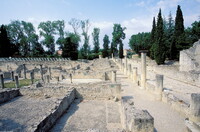Vaison-la-Romaine [Roman site]
unknown (Ancient Roman)

Download1A3-R-F-VRR-D3_cp.jpg (717.6Kb)
Date
-125-400Description
View looking north on the main street, depicting remains of the colonnade on the west side; Vaison-la-Romaine (Latin: Vasio Vocontiorum) is a small town and former bishopric in Provence. After the Roman conquest (125-118 BCE) the Vocontii retained a certain degree of autonomy; they had two capitals, Luc-en-Diois (in modern Drôme département), apparently the religious center, and Vaison. Their continued authority in the gradual Romanization of the Celtic oppidum meant that the city plan incurred no disruptive re-founding along rigid Roman orthography. The city's modern archaeologist Christian Goudineau has suggested that early examples were set by Vocontian aristocrats who moved down from the oppidum and established villas along the river, around which the Gallo-Roman city accreted. In the Roman period it became one of the richest cities of Gallia Narbonensis, with numerous geometric mosaic pavements, a fine small theatre on a rocky hillslope, probably built during the reign of Tiberius, whose statue was found in a prominent place on its site. The Polyclitan Diadumenos now in the British Museum was discovered in the theatre in the nineteenth century. The barbarian invasions were presaged by a pillaging and burning in 276, from which Roman Vasio recovered, but in the fifth century the benches of the theatre began to be reused as Christian tombstones Source: Wikipedia; http://en.wikipedia.org/wiki/Main_Page (accessed 7/17/2008)
Type of Work
excavation (site)Subject
architectural exteriors, business, commerce and trade, cityscapes, domestic life, genre, Roman Empire, Imperial (Roman)
Rights
Rights Statement
Licensed for educational and research use by the MIT community only